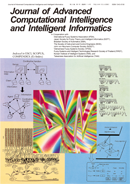Volume 18, Issue 3
Displaying 1-28 of 28 articles from this issue
- |<
- <
- 1
- >
- >|
Regular Papers
-
Article type: Paper
2014Volume 18Issue 3 Pages 253-261
Published: May 20, 2014
Released on J-STAGE: July 01, 2019
Download PDF (1124K) -
Article type: Paper
2014Volume 18Issue 3 Pages 262-270
Published: May 20, 2014
Released on J-STAGE: July 01, 2019
Download PDF (2693K) -
Article type: Paper
2014Volume 18Issue 3 Pages 271-279
Published: May 20, 2014
Released on J-STAGE: July 01, 2019
Download PDF (1231K) -
Article type: Paper
2014Volume 18Issue 3 Pages 280-288
Published: May 20, 2014
Released on J-STAGE: July 01, 2019
Download PDF (244K) -
Article type: Paper
2014Volume 18Issue 3 Pages 289-296
Published: May 20, 2014
Released on J-STAGE: July 01, 2019
Download PDF (371K) -
Article type: Paper
2014Volume 18Issue 3 Pages 297-304
Published: May 20, 2014
Released on J-STAGE: July 01, 2019
Download PDF (888K)
Special Issue on CogInfoCom 2012
-
Article type: Editorial
2014Volume 18Issue 3 Pages 305
Published: May 20, 2014
Released on J-STAGE: July 01, 2019
Download PDF (45K) -
Article type: Paper
2014Volume 18Issue 3 Pages 306-310
Published: May 20, 2014
Released on J-STAGE: July 01, 2019
Download PDF (224K) -
Article type: Paper
2014Volume 18Issue 3 Pages 311-314
Published: May 20, 2014
Released on J-STAGE: July 01, 2019
Download PDF (139K) -
Article type: Paper
2014Volume 18Issue 3 Pages 315-319
Published: May 20, 2014
Released on J-STAGE: July 01, 2019
Download PDF (1187K) -
Article type: Paper
2014Volume 18Issue 3 Pages 320-323
Published: May 20, 2014
Released on J-STAGE: July 01, 2019
Download PDF (582K) -
Article type: Paper
2014Volume 18Issue 3 Pages 324-330
Published: May 20, 2014
Released on J-STAGE: July 01, 2019
Download PDF (1282K)
Selected Papers from SCIS&ISIS2012
-
Article type: Paper
2014Volume 18Issue 3 Pages 331-339
Published: May 20, 2014
Released on J-STAGE: July 01, 2019
Download PDF (246K) -
Article type: Paper
2014Volume 18Issue 3 Pages 340-346
Published: May 20, 2014
Released on J-STAGE: July 01, 2019
Download PDF (1152K) -
Article type: Paper
2014Volume 18Issue 3 Pages 347-352
Published: May 20, 2014
Released on J-STAGE: July 01, 2019
Download PDF (683K) -
Article type: Paper
2014Volume 18Issue 3 Pages 353-360
Published: May 20, 2014
Released on J-STAGE: July 01, 2019
Download PDF (373K) -
Article type: Paper
2014Volume 18Issue 3 Pages 361-365
Published: May 20, 2014
Released on J-STAGE: July 01, 2019
Download PDF (367K) -
Article type: Paper
2014Volume 18Issue 3 Pages 366-374
Published: May 20, 2014
Released on J-STAGE: July 01, 2019
Download PDF (253K) -
Article type: Paper
2014Volume 18Issue 3 Pages 375-382
Published: May 20, 2014
Released on J-STAGE: July 01, 2019
Download PDF (1694K) -
Article type: Paper
2014Volume 18Issue 3 Pages 383-390
Published: May 20, 2014
Released on J-STAGE: July 01, 2019
Download PDF (169K) -
Article type: Paper
2014Volume 18Issue 3 Pages 391-400
Published: May 20, 2014
Released on J-STAGE: July 01, 2019
Download PDF (1618K) -
Article type: Paper
2014Volume 18Issue 3 Pages 401-408
Published: May 20, 2014
Released on J-STAGE: July 01, 2019
Download PDF (487K) -
Article type: Paper
2014Volume 18Issue 3 Pages 409-417
Published: May 20, 2014
Released on J-STAGE: July 01, 2019
Download PDF (1022K) -
Article type: Paper
2014Volume 18Issue 3 Pages 418-428
Published: May 20, 2014
Released on J-STAGE: July 01, 2019
Download PDF (3515K) -
Article type: Paper
2014Volume 18Issue 3 Pages 429-434
Published: May 20, 2014
Released on J-STAGE: July 01, 2019
Download PDF (338K) -
Article type: Paper
2014Volume 18Issue 3 Pages 435-442
Published: May 20, 2014
Released on J-STAGE: July 01, 2019
Download PDF (614K) -
Article type: Paper
2014Volume 18Issue 3 Pages 443-450
Published: May 20, 2014
Released on J-STAGE: July 01, 2019
Download PDF (1643K) -
Article type: Paper
2014Volume 18Issue 3 Pages 451-458
Published: May 20, 2014
Released on J-STAGE: July 01, 2019
Download PDF (2036K)
- |<
- <
- 1
- >
- >|
